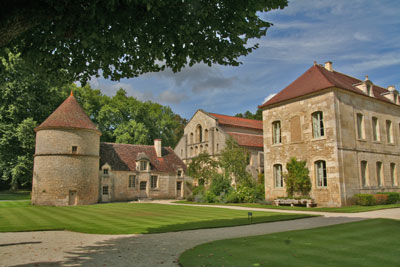Fontenay Abbey
 Beyond the big chicken of Bresse lies Fontenay Abbey. Close to Dijon, this abbey was a harsh place to live. The cold stone walls were built way back in 1118, and the heating was kept only to a minimum, with just the kitchen, the hospital and one other room heated, where monks would warm their freezing hands in order to continue writing. During the nineteenth Century, the abbey was turned into a paper mill, but by the twentieth Century, restoration work had begun, and today you have a tourist attraction.
Beyond the big chicken of Bresse lies Fontenay Abbey. Close to Dijon, this abbey was a harsh place to live. The cold stone walls were built way back in 1118, and the heating was kept only to a minimum, with just the kitchen, the hospital and one other room heated, where monks would warm their freezing hands in order to continue writing. During the nineteenth Century, the abbey was turned into a paper mill, but by the twentieth Century, restoration work had begun, and today you have a tourist attraction.
The two buildings that you see in front here were added later, as you may have guessed by the style that’s a bit more modern than the twelfth Century! There are privately owned areas that the public aren’t allowed to enter. And, in fact, if you sit on the grass right next to the public walkway, a man will come over and ask you to get off the private property. Yes, I sat on the grass.
The most interesting things about the abbey were meant to be the lifestyle of the monks, the big ceiling made of wood that was like an upside-down boat hull, and the water mill. However, most of us on the tour were more interested in checking out the bats, the beehives and the jumping fish in the pond by the water mill. We also learnt that it’s quite difficult to take a good photo of a jumping fish.
I digress, but that’s kind of what I did during the tour of the abbey. I think, perhaps, in my ten years of looking at stuff that’s older than anything we have in Australia, I’ve seen so many abbeys, monasteries, churches and castles that I’m now just a bit underwhelmed unless they’re amazing. But the jumping fish, I’d go again to see them.

Interesting priorities…heated kitchen with unheated bedroom?
Hi Jack. Yes, the kitchen was heated by the oven! Not traditional heating – just some default warmth.